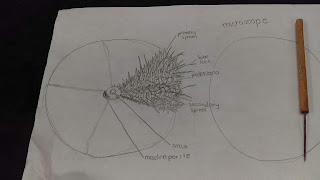One of the teachers attending with the group has a personal connection as she came to the Huntsman in 1986 as a high school student. Just by coincidence pictures of her class were featured on the front page of the most recent issue of our newsletter, SeaWords. We are very happy that fond memories of the Huntsman encouraged her to come back with her students!
Studying urchin anatomy.
View through the microscope.
Identifying the pattern on the urchin.
One of the urchins started spawning during the lab.
Touring the Atlantic Reference Centre (ARC), a research museum run jointly between the Huntsman and the Department of Fisheries and Oceans.
Deep sea shrimp. Look at those huge eyes!
The grand finale of the tour, a porbeagle shark head.
One the search for invasive green crabs.
Data is collected on the size and sex of each crab.
The group found 202 crabs in just one hour!
The students played a round of plankton bingo. Everyone found copepods in the sample.
Conducting an experiment to see if temperature effects the feeding rate of barnacles.

















































